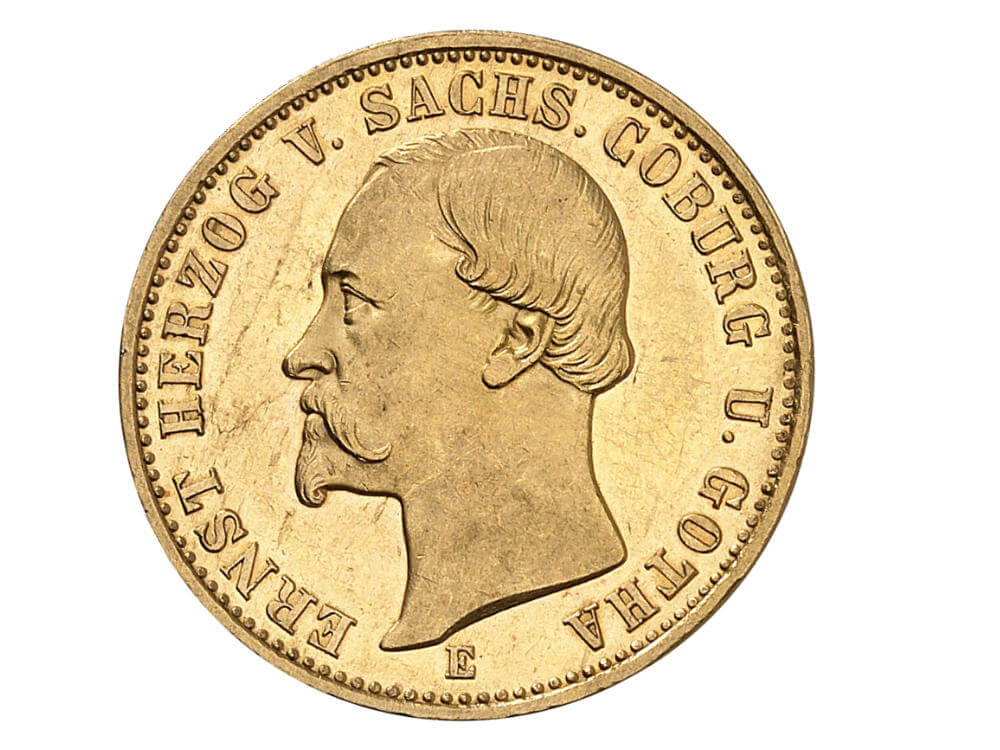From Taler to Mark: The Long Road to a Common Currency
In the years between 1800 and 1914, Germany developed from an agricultural patchwork of countless separate territories into a unified industrial nation. If you are interested in German history, you will be familiar with the major steps of this development: from the student protests after the Congress of Vienna to the failed revolution of 1848, Prussia’s three “wars of unification” and the founding of the German Empire.
Content
So, was the German nation-state the result of patriotic sentiment combined with Prussia’s high ambitions as a military power? That would be too much of a simplification, after all, economic factors also played into this. Customs barriers and the different currencies that circulated in a myriad of small states hampered trade and were increasingly considered medieval by citizens. Countries such as France and Great Britain had long become unified economic areas and were discussing free trade agreements. Germany still had a long way to go.
Therefore, German politicians in the 19th century endeavored to facilitate the exchange of goods and to harmonize currencies. Coinage treaties gradually paved the way for the common currency that was introduced in the new German Empire. We will illustrate this development with the coins of the Double Duchy of Saxe-Coburg and Gotha, of which some rare and outstandingly preserved pieces can be found in Künker’s auction 388. The sale will be held on 22 June 2023 and present a North German private collection under the title “Taler and Mark”.
The Initial Situation
In the late 18th century, German territorial states minted their own coins according to various weight standards. While the so-called “Scheidemünzen”, i.e. coins whose metal value was below their face value, circulated within the state in question, currency money was used for cross-border trade. Therefore, the value of currency money was determined by its silver content. The Cologne mark, a weight unit that corresponded to about 234 grams of silver, had been at the center of this weight system since the Middle Ages. Therefore, the basic question was how many coins were to be minted from one Cologne mark of silver. Prussia, for example, had introduced a standard of 14 talers in 1750, according to which 14 talers were minted from 234 grams of fine silver. Around 1800, this weight standard was predominant in northern Germany.
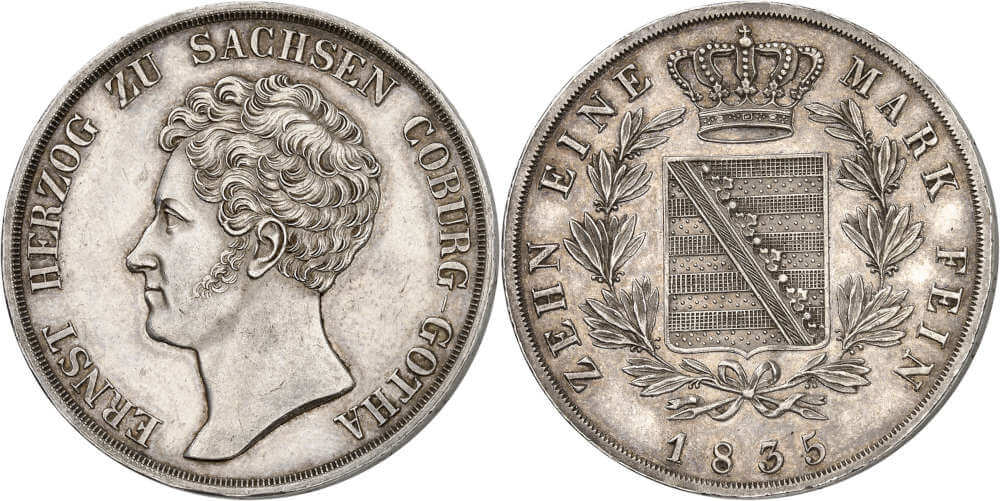
Duchy of Saxe-Coburg and Gotha, Ernest I. Konventionstaler 1835. Very rare. Extremely fine. From Künker auction 388 (22 June 2023), No. 1643. Estimate: 5,000 euros.
The Duchy of Saxe-Coburg and Gotha took a different approach. This is illustrated by this 1835 konventionstaler, minted under Duke Ernest I. The name of the coin derives from the coinage treaty (a “Konvention”) concluded between Austria and Bavaria in 1753, according to which the old reichstaler was replaced by a new silver coin. This konventionstaler established itself in large parts of southern and western Germany, including the Saxon duchies. The legend on the konventionstaler tells us more about its weight standard. It reads “ZEHN EINE MARK FEIN” (ten of one fine mark). This means that 10 such talers were minted from one Cologne mark of silver and thus corresponded to 14 Prussian talers – at least regarding their precious metal content.
So this is where things get complicated. In southern Germany, the gulden was the main currency of account. The value of every taler was therefore measured in gulden. But since the price of silver was constantly changing, the value of the (Prussian) taler changed, too. Thus, merchants were faced with the problem that it was difficult to calculate the exchange rate between the (southern German) gulden of account and the (Prussian) taler. Therefore, the Coinage Treaty of 1753 laid down requirements for the taler that made it easy to calculate its value in the gulden currency.
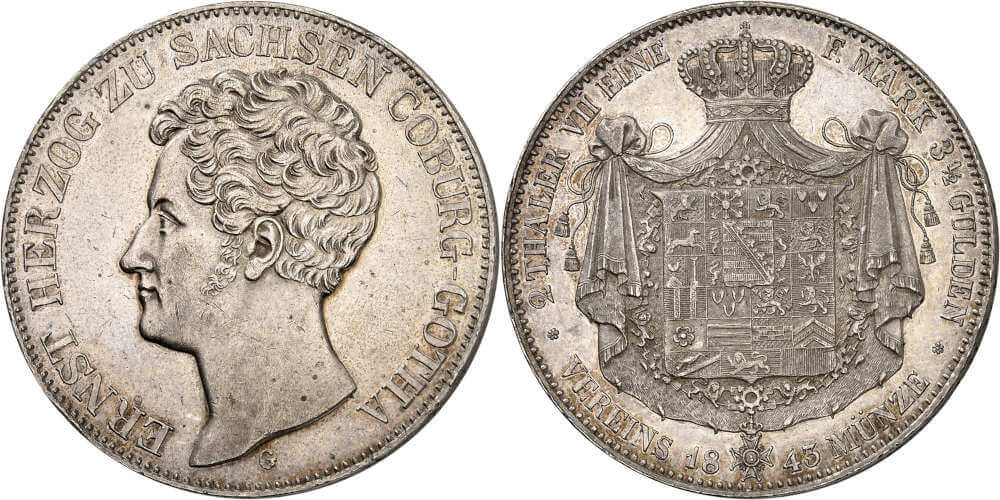
Duchy of Saxe-Coburg and Gotha, Ernest I. Double vereinstaler, 1843. About extremely fine. From Künker auction 388 (22 June 2023), No. 1644. Estimate: 1,000 euros.
One Coin, Two Face Values
A double taler of 1843 takes us to the next stage. It is the result of far-reaching reforms. The German Customs Union had already been founded in 1833. This not only ensured that annoying customs barriers were removed but also provided for a future standardization of currencies. A breakthrough was achieved with the Munich Coinage Treaty of 1837 and the Dresden Coinage Treaty of the following year. The newly founded South German Coinage Union set the Cologne mark at 24 1/2 gulden – before it had been 24 gulden. This enabled a clear relation between the (southern German) gulden and the (Prussian) taler: 1 taler corresponded to 1.75 gulden.
This new exchange rate was underpinned by a new currency money coin that was accepted in the entire region of the customs union. Therefore, it was called “vereinsmünze” (union coin). This double taler of 1843 is such a vereinsmünze. The reverse legend mentions two face values: “2 THALER VII EINE F. MARK 3 ½ GULDEN”, which means that this coin is worth 2 talers according to the Prussian weight standard of 14 talers per Cologne mark, and 3 1/2 gulden regarding the southern German standard of 24.5 gulden per mark.
Duke Ernest I of Saxe-Coburg and Gotha was highly interested in this reform of the coinage system because it helped him personally. We have to remember that Saxe-Coburg and Gotha was not a single duchy but a personal union that combined two duchies: Saxe-Gotha and Saxe-Coburg. While the Prussian taler was used in the Duchy of Gotha, Coburg – which was located further south and a member of the South German Coinage Union – calculated with the gulden. This means that a common base for both territories would greatly facilitate everyday life in Saxe-Coburg and Gotha.
The double taler combined the currency areas of northern and southern Germany and was therefore of significant symbolic meaning. In daily live, however, this coin was hardly ever used due to its high denomination.
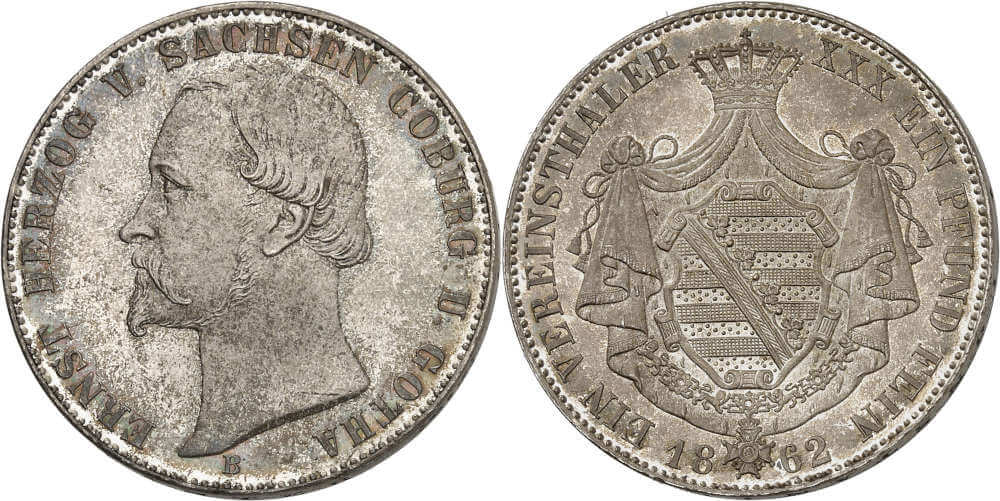
Duchy of Saxe-Coburg and Gotha, Ernest II. Vereinstaler 1862. Gem. FDC. From Künker auction 388 (22 June 2023), No. 1646. Estimate: 1,500 euros.
The Cologne Mark Becomes Outdated
A further step towards the harmonization of currencies was the Vienna Monetary Treaty of 1857. For the first time, an actual common coin was created, the vereinstaler. Here we see a specimen from 1862, minted under Duke Ernest II of Saxe-Coburg and Gotha. What was downright revolutionary about this coin was that the medieval Cologne mark was no longer used as the basis of the weight standard, but the decimal “Zollpfund” (customs pound), i.e. 500 grams of silver.
Our coin’s legend “EIN VEREINSTALER XXX EIN PFUND FEIN” (one vereinstaler xxx one pfund fine) tells us that 30 vereinstalers were minted from one pfund of fine silber. This was very clever as the precious metal content of the Prussian taler was only changed by the fraction of a gram, despite all the theoretical changes.
With the vereinstaler, the currency areas were finally connected by a common main coin. The fact that Austria and Liechtenstein joined the currency area with the treaty, on the other hand, had hardly any long-term consequences. As early as in 1866, they left the currency area again after the lost Austro-Prussian War.
Duke Ernest II of Saxe-Coburg and Gotha certainly welcomed the Vienna Monetary Treaty. He was considered a great advocate of national unification and, unlike some of his neighbors, sided with Prussia in the war against Austria. The victory over Austria was an important milestone on the road to the unification of the empire under Prussian leadership. After the victory against France in the war of 1870/71, the time had come: the German Empire was proclaimed in the Hall of Mirrors at Versailles.
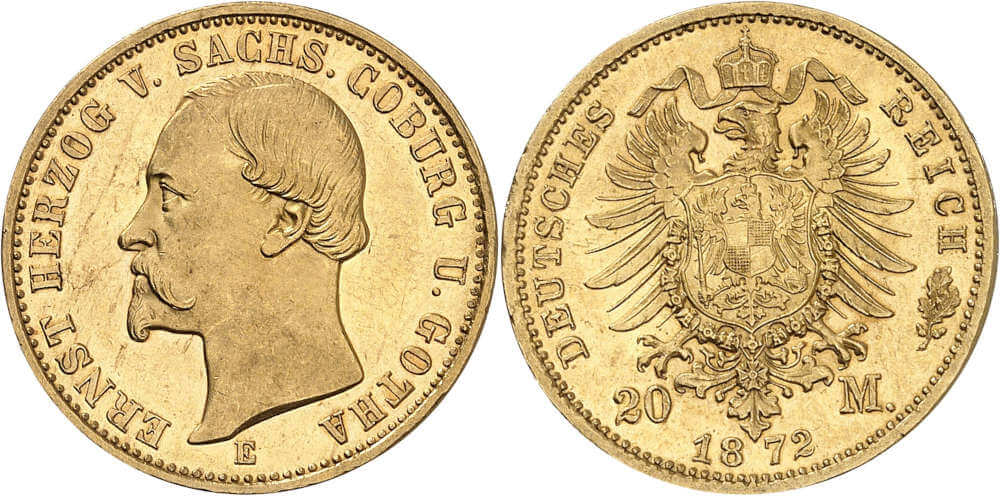
German Empire. Duchy of Saxe-Coburg and Gotha. 20 marks 1872. Very rare, especially in this quality. Extremely fine to FDC. From Künker auction 388 (22 June 2023), No. 1927. Estimate: 100,000 euros.
Finally, a Common Currency!
With the new empire, finally a uniform imperial currency was created, the details of which were stipulated in various coinage laws. They were based on the achievements of the previous decades. At the time, the decimal system, which had repeatedly been proposed before, was introduced: 1 mark were to equal 100 pfennigs, easy and practical. The silver standard was abandoned. Instead, following the British model, the gold standard was introduced. We take this fact into account by depicting a gold coin this time. It is the famous 20-mark piece of Saxe-Coburg and Gotha of 1872, known as the rarest of all imperial gold coins. It shows that the coin specifications had been harmonized but that gold and silver coins were still issued on behalf of the states and with the portraits of their princes.
The introduction of the imperial currency put an end to the tedious efforts of the 19th century to unify the coinage system. As in politics, Prussia had asserted its dominance regarding the main aspects of the development.





